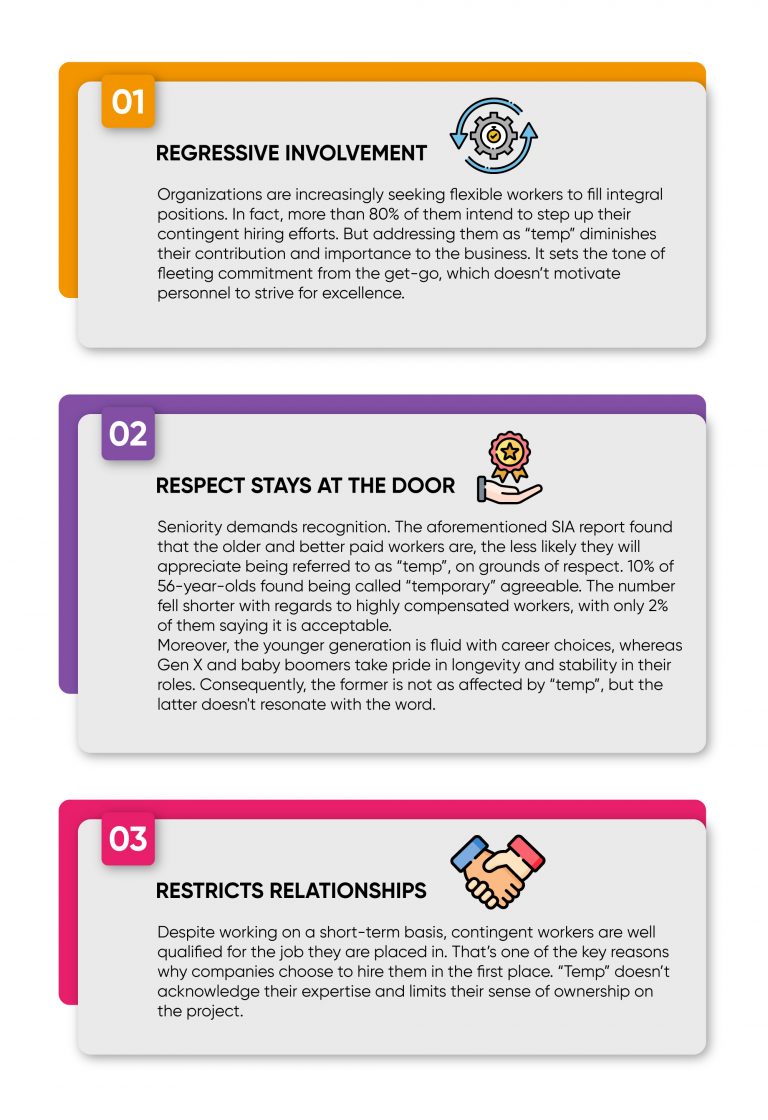What’s in a job title? A job title isn’t just a moniker that’s assigned to someone to distinguish their role in a company; it is a part of their professional identity. And this importance is no different for contingent workers versus employees of a company.
Much like an employee, a job title is significant to a contingent worker, regardless of if they are an agency hire, directly sourced, leased, or independent. It shows their standing in the organizational ladder in the course of their stint and can stick in their portfolio for years to come. It’s no surprise then that a 2021 report by Staffing Industry Analysts (SIA) found that contingent workers felt “temporary” to be an ill-fitting designation.
“Why is it necessary to consider this matter and its repercussions”, you ask? For one, the U.S. gig economy comprises over 57 million workers, which is a sizable segment of people to discount. And two, their experience with the company is crucial to securing their loyalty and maintaining reputation, without which the future of the workforce can be jeopardized.
Why “Temp” Can Be the Wrong Descriptor for Contingent Workers
By nature, the term “temporary” is short-lived. In the case of fixed-term labor, this can convey the wrong connotations and cause apprehension in many ways.
- Regressive involvement
Organizations are increasingly seeking flexible workers to fill integral positions. In fact, more than 80% of them intend to step up their contingent hiring efforts. But addressing them as “temp” diminishes their contribution and importance to the business. It sets the tone of fleeting commitment from the get-go, which doesn’t motivate personnel to strive for excellence.
- Respect stays at the door
Seniority demands recognition. The aforementioned SIA report found that the older and better paid workers are, the less likely they will appreciate being referred to as “temp”, on grounds of respect. 10% of 56-year-olds found being called “temporary” agreeable. The number fell shorter with regards to highly compensated workers, with only 2% of them saying it is acceptable.
Moreover, the younger generation is fluid with career choices, whereas Gen X and baby boomers take pride in longevity and stability in their roles. Consequently, the former is not as affected by “temp”, but the latter doesn’t resonate with the word.
- Restricts relationships
Despite working on a short-term basis, contingent workers are well qualified for the job they are placed in. That’s one of the key reasons why companies choose to hire them in the first place. “Temp” doesn’t acknowledge their expertise and limits their sense of ownership on the project.

Plus, it’s necessary for them to integrate with their team and the company culture for the duration of their tenure, but “temp” takes away from their feeling of belonging.
Appropriate Descriptors to Use
Though “temporary” doesn’t sit well, there is no shortage of other descriptors that can and should be used in its place. They are sometimes interchangeable, depending on the scope of work. As a business, the descriptor you use for contingent workers can make or break your ability to get the candidates you desire and build the workforce you envision. As a colleague, it’s essential that you treat contingent workers as peers. In both cases, it’s best to clarify the descriptor and definitely use an alternative to “temp”.
The most preferred and popular descriptors in contingent worker circles are:
- Contractor: A wide range of roles fall under the category of contractor; as such, anyone who provides independent services can be called a contractor, from a doctor to a real estate agent. Labor-intensive or technical jobs are typically associated with this descriptor.
- Consultant: By definition, a consultant is someone who offers expert advice. They can be a specialist of any right, in any industry. “Consultant” is most often used in the context of management, programming, finance, and supply chain strategy.
- Freelancer: This descriptor is generally suitable for those in virtual or creative positions, such as personal assistants, writers, graphic designers, illustrators, musicians, and so on.
- Associate: Interns or those in junior positions can be referred to as associates, to indicate their minimal experience level without any negative implications.
- Team Member: This descriptor emphasizes that all individuals that are associated with the company or department are part of the same team, and that every role is essential. It also brings attention to the fact that working together is paramount to achieving great outcomes.
- Non-employee: Some businesses describe their workforce as consisting of employees and non-employees. While this is a fact, it makes non-employees feel different and the identifier “non” has a negative connotation.
Having made it this far, you either already have a strong contingent workforce that you want to appreciate, or you hope to build one soon. With Prosperix’s suite of essential workforce solutions, our team of experts can help you grow and nurture an extraordinary workforce. To learn more, check out our workforce solutions offerings or visit www.prosperix.com.

